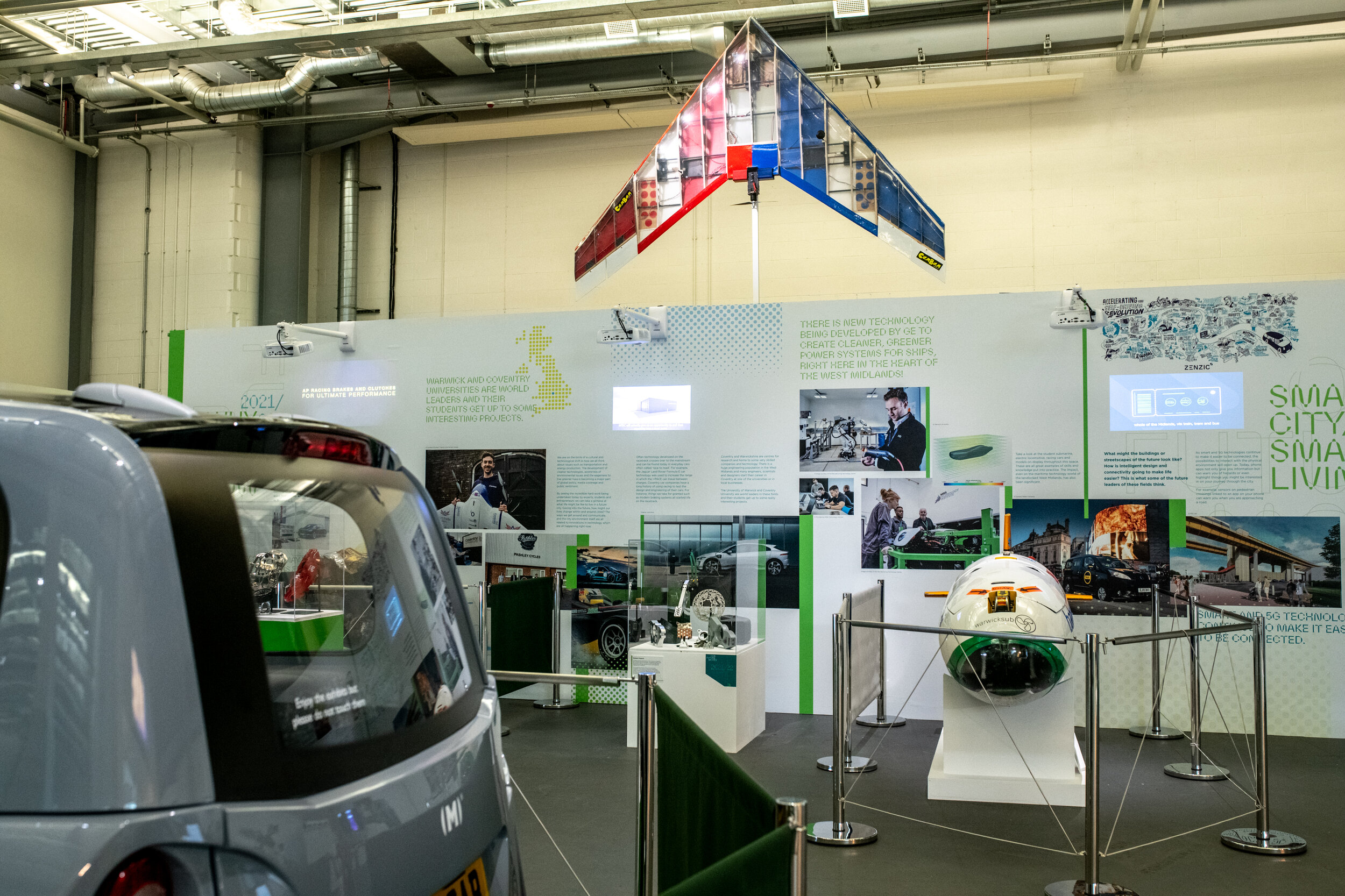
Our Future Moves
Why Here // Why Now
Coventry, Warwickshire and the West Midlands have a long history of innovation, inventions and industry. From the Father of the Cycle Industry, James Starley to iconic cars. From Sir Frank Whittle’s jet engines to electric vehicles and self-driving pods, some of the best technology was pioneered here. Coventry and Warwickshire is the home of the Rover Safety Cycle, the London Electric Taxi, as well as cutting edge mechanical parts and even holograms which were invented in Rugby!
Video supplied by Horiba Mira.
Have you ever stopped to think about the engineering and resources that go into making a car? Metal, wood, plastics and fabrics are all used, and making these parts can be both time consuming and energy draining. However, can these materials be made greener? Can they be recycled? How can you reduce the carbon footprint? These are all questions curious people in the region are looking to answer. Today, Coventry and Warwickshire are centres for research and development, testing production and maintenance of electric and low carbon vehicles.
The issue of how we deal with our waste is a big problem for society, and many examples of technology try to address this challenge in some way. Recycling entire vehicles is relatively new for the industry and has been too costly and complicated to do so in the past. However, some new innovations are finding their way into the mainstream to make this possible. For example, converting older vehicles to electric instead of having them crushed and put into landfill can be one way to give an older piece of technology a new lease of life. It also avoids creating additional waste, but it is not easy, cars often need lots of work to be able to carry the change in weight from the batteries needed to help power them.
By 2050 we may expect to see cars from the present day given the ‘electrification’ treatment as fossil fuelled versions are gradually being phased out with no new fossil fuelled vehicles sold by 2030. Improvements in battery technology and more businesses offering vehicle conversions would help this method and make it a more affordable option.
The story of how today’s ideas become tomorrow’s experiences is a complex and exciting one.
Crushed Imp
This Hillman Imp was owned by singer Jarvis Cocker who gave it away after it was crushed in a competition for fans. You can see by its name badge it was made in Coventry. As a crushed cube it gives you a great idea of the amount of metal found inside a car.

We are on the brink of a cultural and technological shift in how we all think about issues such as transportation and energy production. The development of cleaner technologies, awareness of environmental issues and the eagerness to live greener lives is becoming a major part of global policy, media coverage and public sentiment.
Coventry and Warwickshire are centres for research and home to some very skilled companies and technology. There is a huge engineering population in the West Midlands and many engineers, scientists and designers start their career in the West Midlands at one of the universities or in local businesses.
As part of their engineering course University of Warwick students get to take part in a range of projects. For the Submarine team the challenge is to design, build and race a human powered submarine often competing in international competitions.
The team have access to cutting edge engineering research from both WMG at the University of Warwick and the Warwick School of Engineering and each year focus on different element improving the design year on year.
Often technology developed on the racetrack crosses over to the mainstream and can be found today in everyday cars often called ‘race to road’. For example, the Jaguar Land Rover Formula E car technology was used to increase the range in which the I-PACE can travel between charges. Coventry car companies have a long history of using racing to test the design and engineering of their cars. For instance, things we take for granted such as modern braking systems all started life on the racetrack.
Students studying engineering at the University of Warwick gain valuable practical and project management skills as part of a range of projects. The Warwick Racing student team design and build single seat race cars for participation at international competitions.
This is a state-of-the-art F1 brake caliper, high end brake caliper and a clutch all made by AP Racing, one of the leading manufacturers of performance brake and clutch systems for road and race cars, who are based here in Coventry.
Other items on display include examples of a battery bus bar, supporting struts and brake system parts all designed, made and fitted by the University of Warwick students in the team with help from the technical staff.
For other new fuel technologies such as hydrogen, wind and solar power, it's easy to create their energy but the tricky part can be finding ways to store this energy ready for use when it's needed.
Hydrogen and fuel cells can be used to power trucks, buses, vans and cars, ships, trains, fork-lift trucks and drones as well as being used in homes and industry. Space rockets use liquid hydrogen to blast into space and now aircrafts are starting to be tested with hydrogen as a fuel. It is the lightest and most abundant element in the universe.
Battery Pack and Module
This is a 24V battery pack and battery management system using a Lithium Iron Phosphate cell. Each car has 3 packs, and each pack has 2 modules.
Microcab Hydrogen Storage Vessel
This is a wound carbon filament Type 4 tank. It stores 0.6kg of compressed hydrogen at 350bar.
Fuel Cell System
This is a proton exchange air cooled fuel cell stack and balance of plant. It converts hydrogen into electricity with the emission of water only. The power output is 3.5kW.












